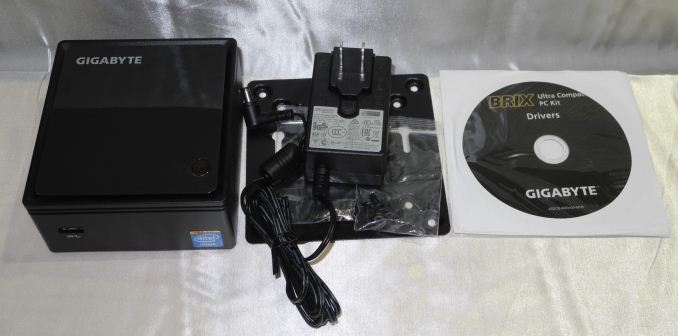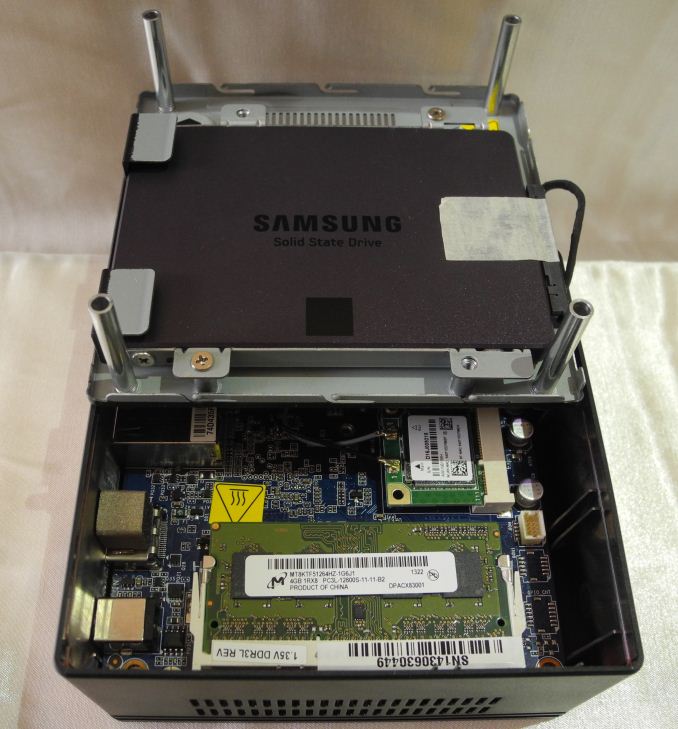GIGABYTE BRIX GB-BXBT-1900 Review: A Bay Trail UCFF PC
by Ganesh T S on October 24, 2014 12:10 PM EST
Introduction and Setup Impressions
Over the last couple of years, the ultra-compact form factor (UCFF) has emerged as one of the bright spots in the troubled PC market. Intel kickstarted the category with their Sandy Bridge NUC kits in early 2013. Recognizing the popularity of this segment, other vendors also began to promote similar products. GIGABYTE targets this market segment with an extensive lineup of products under the BRIX brand. We recently looked at the high-end Haswell BRIX, the GB-BXi7-4500. The focus of this review is on the opposite side of the spectrum - they Bay Trail-D Celeron J1900-based GB-BXBT-1900. As a note, due to GIGABYTE's regional marketing policies, this model is currently not being sold in the North American market, but targets price conscious buyers everywhere else.
Similar to other BRIX units, the BXBT-1900 comes barebones. An important point to note is that, unlike the higher-end BRIX units, the BXBT-1900 doesn't support mSATA drives. The support for 2.5" drives makes the z-height a bit more than the BRIX s (pure mSATA) models that we have looked at before. The dimensions (56.1 mm x 107.6 mm x 114.4 mm) otherwise conform to the smallest possible BRIX units (29.9 mm x 107.6 mm x 114.4 mm). Another point of difference is the presence of only one SO-DIMM DDR3L slot rated for operation at 1333 MHz (compared to the dual 1600 MHz-capable slots in the Haswell-based units). We configured the review unit to end up with the following components:
| GIGABYTE GB-BXBT-1900 Specifications | |
| Processor | Intel Celeron J1900 (4C/4T x 2.00 GHz (2.41 GHz Turbo), 22nm, 2MB L2, 10W) |
| Memory | 1 x 4GB DDR3L-1600 |
| Graphics | Intel HD Graphics |
| Disk Drive(s) | Samsung SSD 840 EVO 120GB 2.5" SSD |
| Networking | 1x Gigabit Ethernet, 1x1 802.11n/Bluetooth mPCIe |
| Audio | Capable of 5.1/7.1 digital output with HD audio bitstreaming (HDMI) |
| Operating System |
Retail unit is barebones, but we installed Windows 8.1 Pro x64 |
| Pricing (As configured) | ~$170 (barebones) + $129 (DRAM + 2.5" SSD) |
| Full Specifications | GB-BXBT-1900 Specifications |
The BXBT-1900 kit doesn't come with any pre-installed OS, but does come with a driver CD. In the higher-end kits, GIGABYTE has moved to USB keys for the drivers. In any case, we ended up installing the latest drivers downloaded off GIGABYTE's product support page. In addition to the main unit, the other components of the package include a 30 W (12V @ 2.5A) adapter, a US power cord, a VESA mount (along with the necessary screws), a driver CD and a quick-start guide.
The gallery below takes us around the hardware in the unit.
In order to complete our build, we opted for a 2.5" Samsung SSD 840 EVO (with the read performance bug recently fixed) and a single Crucial CT51264BF160B (Micron 8KTF51264HZ-1G6J1) 4 GB SO-DIMM.
In the table below, we have an overview of the various systems that we are comparing the BXBT-1900 against. Note that they may not belong to the same market segment. The relevant configuration details of the machines are provided so that readers have an understanding of why some benchmark numbers are skewed for or against the BXBT-1900 when we come to those sections.
| Comparative PC Configurations | ||
| Aspect | GIGABYTE GB-BXBT-1900 | |
| CPU | Intel Celeron J1900 | Intel Core i5-4250U |
| GPU | Intel HD Graphics | Intel HD Graphics 5000 |
| RAM | Crucial CT51264BF160B (Micron 8KTF51264HZ-1G6J1) 11-11-11-28 @ 1600 MHz 1x4 GB |
Crucial CT51264BF160B (Micron 8KTF51264HZ-1G6J1) 11-11-11-28 @ 1600 MHz 2x4 GB |
| Storage | Samsung SSD 840 EVO (120 GB, 2.5in SATA 6Gb/s, 19nm, TLC) |
Intel SSD 530 Series (180 GB, PCIe Module mSATA 6Gb/s, 20nm, MLC) |
| Wi-Fi | Realtek 8723BE Wireless LAN 802.11n (1x1 802.11n - 150 Mbps) |
Intel Dual Band Wireless-AC 7260 (2x2 802.11ac - 867 Mbps) |
| Price (in USD, when built) | $292 | $680 |


















35 Comments
View All Comments
LoneWolf15 - Thursday, October 30, 2014 - link
I would buy one of these --or another Bay Trail NUC in this price range --if they made a good faith effort to support Linux. This particular system config is tailor-made for an appliance style box. But I've read time and time again about NUC-style vendors (this particular Gigabyte model, and others) saying "We only support Windows on this unit". I'm a Windows guy and all, but the use I'd have for this is like an Asterisk server at home for VoIP or something of that type.ArushaMan - Saturday, September 19, 2015 - link
Has anyone upgraded one of these from Win7 to Win8/Win10? I made one attempt and it failed with no explanation. I suspect it has to do with the BIOS setting which requires you to set it for Win7 or Win8 at first install. I installed and activated Win7 OEM, using the Legacy setting. Is the trick to change the setting to Win8 when it re-boots during the Win10 install?BorgDog - Thursday, October 8, 2015 - link
Just got mine yesterday and installed Win7 Starter then upgraded to Win10. Basically the first time windows reboots you need to press the Delete key repeatedly until it goes into Bios then change the setting from Windows 7 to Windows 8.1, then save and exit and it will go back into the Windows 10 install and finish that setup. So short answer, yes that is the trick.andwan0 - Saturday, November 4, 2017 - link
Can the 1900 play HD movie/films @ 1080 or 720 smoothly directly from the HDD or SSD?ansva - Thursday, April 23, 2020 - link
How does this compare to a Raspberry pi 4?